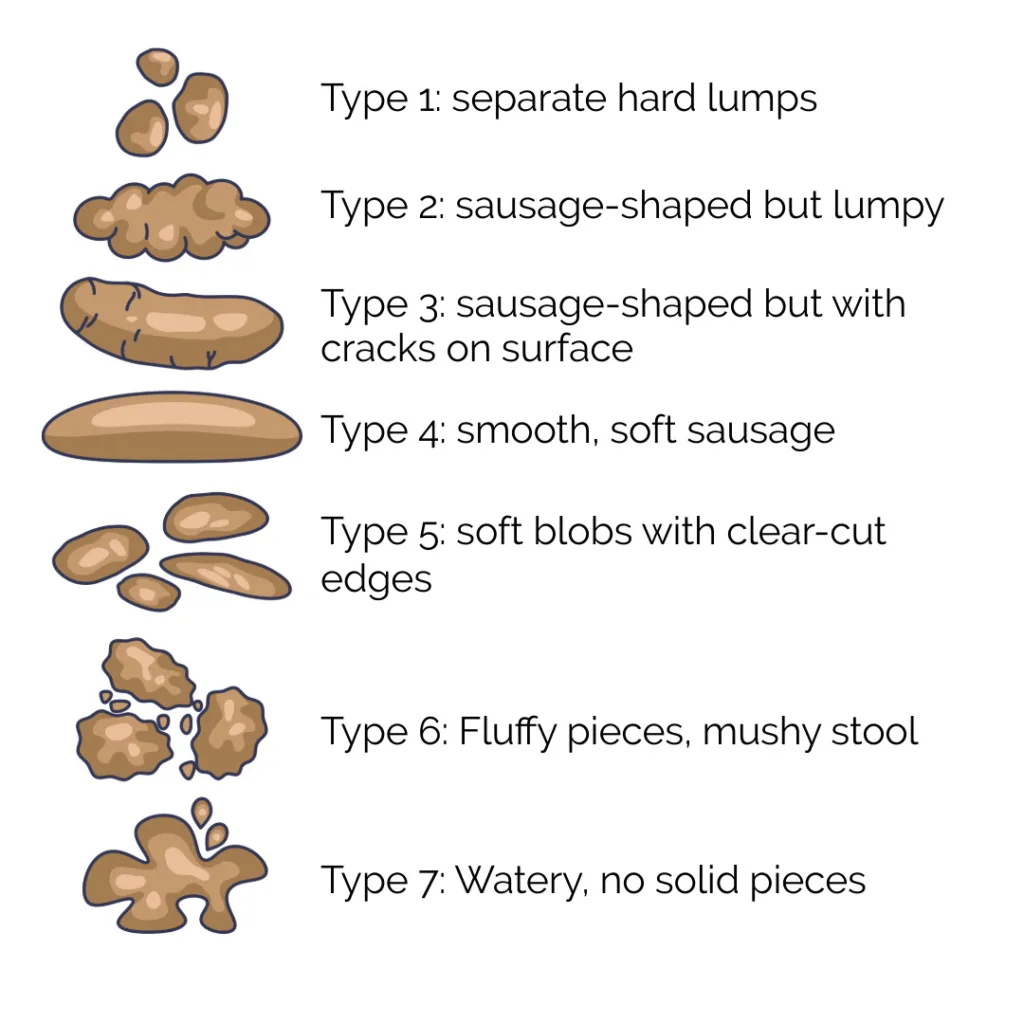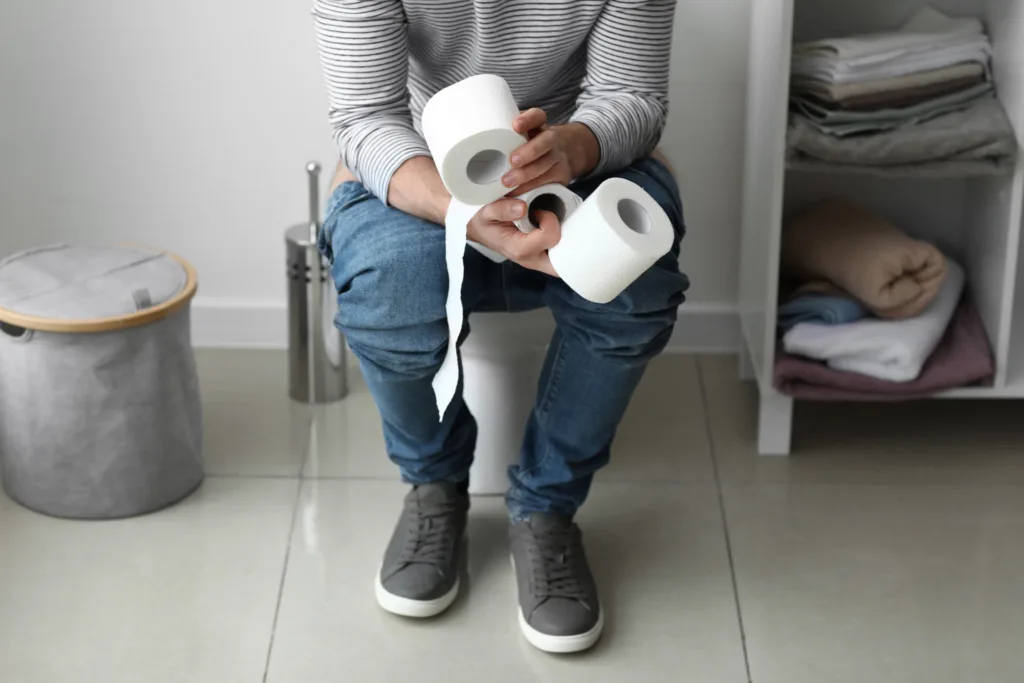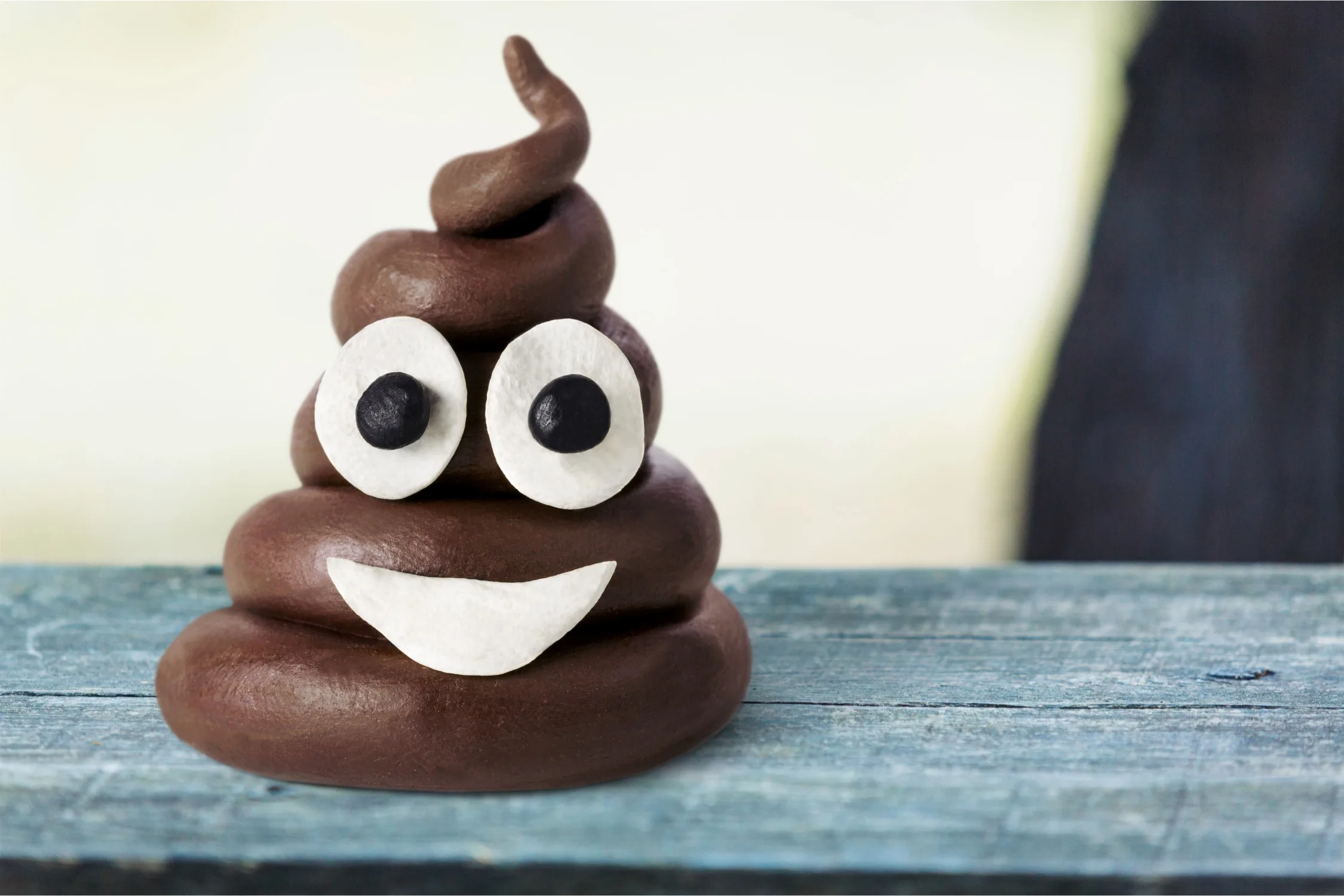Ever wonder why your poop looks different one day than the other? You probably know what constipation and diarrhea are, but what if the color changes, or your poop looks slimy? Your poop can tell you a lot about your gut health, and in some cases also about your overall health, which is why it’s important to keep an eye on your poop regularly.
Keep reading if you want to find out how to “read” your poop!

Frequency
First, let’s talk about BM frequency, or how often you have a number 2. I consider the ideal to be 1-3 times a day, although officially it’s normal to go less often. In fact, what is normal is slightly different for everyone. Someone might feel great with a bowel movement every 3 days, and for someone not pooping every day is already troublesome.
- If you go less than 3 times per week, this is considered constipation, especially if the stool is pebbly and hard.
- At the other end of the spectrum, diarrhea is thought to be 3 or more loose stools per day, or whatever is abnormal to you.
Consistency
Let’s now take a look at the Bristol stool chart to get a real good visual on what an ideal poop is and what it is not:

- Types 1 and 2: constipation
- Types 3 and 4: normal
- Types 5-7: diarrhea
Types 1 and 2 are typically the result of not having enough fiber in the diet (fiber makes stools bigger and easier to pass + fiber can make stool softer), not drinking enough fluids (body takes all the moisture it can from stool to prevent dehydration, which makes stool small and hard), or if the stool is moving too slowly through the digestive system, in which case there’s more time for the intestines to absorb water from poop making it hard. If you don’t eat enough fiber, this can slow the passage of stool through also. Stress can also slow your gut motility and cause constipation, and sometimes the cause could be due to pelvic floor muscle problems. Some medications can cause constipation, for example iron supplements. In functional constipation, there is nothing clear to explain it.
To make things a bit more complicated, sometimes constipation can mask itself as diarrhea, for example in the case of overflow diarrhea where a hard stool plug is preventing poop from exiting and only loose stool can get around it to get out.
Food enters the large intestine in a highly liquid form and lots of water needs to be absorbed before the poop is excreted, otherwise we will get dehydrated. Stool types 5-7 indicate a fast passage of stool through the intestines which leaves not enough time to absorb excess fluid from the stool. Or, sometimes intestines can secrete too much water into the intestine, which moves poop through faster and leads to diarrhea.

Infection is the most common cause of diarrhea. Some medications can loosen stools, such as the common diabetes drug metformin, and also food intolerances, like lactose intolerance can do this. Chronic digestive illnesses, like celiac disease, pancreatitis and inflammatory bowel disease are other relatively common, though more severe, causes of diarrhea. Stress can also cause your bowels to empty too fast. A study from this year found a physical mechanism for this, but more on that later.
With IBS, you can have constipation predominant IBS, diarrhea predominant IBS, or a mixed version of the disorder. There’s also IBS-U, IBS unidentified that doesn’t fit well into any of these categories. Let me know if you’d like to understand the difference between each type of IBS and I’ll write a post about it.
Color of poop
Other visual changes in poop can also be signs of problems in the digestive tract. Some of them are serious. See a summary below of the most common poop changes and what they mean.
| Appearance of poop | Meaning |
| Black and tarry | Bleeding in the upper part of the intestine. Blood is partially digested and turns black. However, a more common cause of black and tarry stools are iron supplements, so if you have been taking iron and your poop turns black, not to worry – it’s normal. If not, talk to your doctor! |
| Black (not tarry) | Foods like blueberries, black licorice, blood pancakes, even dark chocolate. Medications like Pepto-bismol, activated charcoal. |
| Red blood | Bleeding in the lower part of the intestines. This is relatively common and often means you have hemorrhoids that got nicked a bit during pooping. If there are streaks of blood on the poop or there’s some blood on the toilet paper after wiping, it could be because of hemorrhoids (or anal fissures) and likely nothing to worry about. If you are concerned, you can doublecheck with your doctor and you can certainly ask how to manage these issues even if the bleeding is not worrysome. If there’s a bigger amount of bright red blood, like if the water in the toilet turns red, then speak with your doctor ASAP. |
| White/clay-colored | Not enough bile. Bile is produced in the liver, stored in the gallbladder and secreted into the small intestine when we eat (fatty) food. It is necessary for digesting fats. The color of bile is yellow-green, but as it moves through the digestive tract, it changes into that typical poop-brown color. If either the liver is not making enough bile, or the gallbladder is unable to squirt bile into the digestive tract, this color will be missing – without bile your poop is light/white. Talk to your doctor if your poop turns white or clay-colored for more than a couple of days. |
| Yellow/orange/green | As mentioned above, the color of poop comes from bile. If intestines move food faster than normal, there’s not as much time for the bile salts to change color. Some antibiotics can turn poop to an orange or green color. Food dyes can color poop as can some foods, like spinach (green) and carrots (orange). |
| Other colors | First think about what you’ve been eating – this is the most common cause of funny colored poop. Food dyes and beetroot can easily give your poop a festive coloration. If there are no other symptoms, like abdominal pain, diarrhea or vomiting, colors you didn’t expect poop to have is likely just related to what you ate. |
| Floaty, unusually stinky, sticky, loose | Fatty stool. This would indicate a problem in the digestion and absorption of fats, perhaps because of a lack of pancreatic enzymes that digest fats, or problems with bile. Celiac disease can damage intestinal villi and cause reduced absorption of fat and can lead to fatty stools also. Contact your doctor if this problem persists. |
| Food pieces in poop | Many fruit, vegetables and seeds have skins that the body just can’t digest and will show up in your poop. This is normal. Eating too quickly and chewing poorly can increase undigested food in poop. Chew your food thoroughly and see what happens. If you have diarrhea, this issue may become more prominent as there’s less time for the digestive enzymes to work. Usually this is nothing to worry about, but if there are other persistent problems, like abdominal pain, weight loss you can’t explain, vomiting etc, please see your doctor. |
| Mucus | Clear mucus is normal, in fact it helps move poop forward in the GI tract. Irritants can cause your GI tract to produce more mucus than usual, like if you have a viral gut infection. White, bloody, or yellow mucus could indicate that something more serious is going on the gut – talk to your doctor. Get checked also, if there are any other symptoms, like abdominal pain, vomiting, weight loss or diarrhea that lasts longer than a few days. |
There are many reasons why your poop may look different sometimes, and usually it’s nothing to worry about. But if the issue persists, and especially if there are other concerning symptoms, it’s important to contact your healthcare provider. I will also add that even if your symptoms are not clearly indicating that there’s something serious going on, but you are feeling very worried about it, it’s not a bad idea to talk to your doctor anyway. Fear and worry cause a stress response, which can worsen symptoms and cause digestive issues, so it’s better to get your symptoms checked than wait and stay worried.
How does your poop look like? If you are not entirely happy with the consistency of it and would like to get those soft banana poops more often, get in touch! I have some tricks up my sleeve to help you.
PS. Do you have bloating and want to reduce it? Download the free ebook “5 Easy Ways to Beat the Bloat” with powerful ways of boosting your digestion to not feel like an inflated balloon by the evening.
References:
Diaz S, Bittar K, Hashmi MF, Mendez MD. Constipation. 2023 Nov 12. In: StatPearls [Internet]. Treasure Island (FL): StatPearls Publishing; 2025 Jan–. PMID: 30020663.
Nemeth V, Pfleghaar N. Diarrhea. [Updated 2022 Nov 21]. In: StatPearls [Internet]. Treasure Island (FL): StatPearls Publishing; 2025 Jan-. Available from: https://www.ncbi.nlm.nih.gov/books/NBK448082/
DiGregorio AM, Alvey H. Gastrointestinal Bleeding. 2023 Jun 5. In: StatPearls [Internet]. Treasure Island (FL): StatPearls Publishing; 2025 Jan–. PMID: 30725976.
Azer SA, Sankararaman S. Steatorrhea. 2023 May 16. In: StatPearls [Internet]. Treasure Island (FL): StatPearls Publishing; 2025 Jan–. PMID: 31082099.
What Does My Stool (Poop) Color Mean? https://my.clevelandclinic.org/health/articles/stool-poop-color Accessed 10/21/2025
Mucus in Stool (Poop). Cleveland Clinic. https://my.clevelandclinic.org/health/symptoms/mucus-in-stool Accessed 10/21/2025

